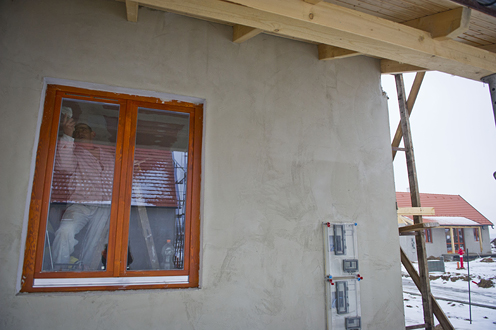National Asset Manager: Idle capacity for more toxicity

It took some trimming on the eligibility criteria, but the National Asset Management Agency is finally closer to its designated purpose. Regardless, the once priority government venture fell well short of all that it was hoped to achieve.
The Orbán cabinet raised the idea of establishing an institution to handle troubled assets and toxic loans as one of the very first of its measures when it took office in 2010 as part of its still ongoing drive to quench household debt.
It was meant to purchase assets about to be foreclosed and where the residents were consequently close to eviction, allowing them to stay on as tenants, while finding a financial solution that was also acceptable to the lending bank.
Over time, the project was put on the back burner, since it lacked overall interest and the eligibility criteria for applying, or even moving to the ‘debtor village’ set up for troubled non-paying families, proved too high.
Slow establishment
Setting up the institution, NET, in itself took well more than a year, there are still numerous obstacles to participating in the program, and there is a good chance that the project is too late to overcome these difficulties at this point, having so far fallen short of every target.
Responding in 2010 to the government’s announced plans, PricewaterhouseCoopers released a research piece on the subject, citing the examples of other countries where local economic situations necessitated similar measures.
For instance, it notes a similar scheme in Malaysia between 1998 and 2002 that eventually saw 92% of troubled policies entered into the program after hammering out terms that were acceptable to all parties. At the end of the period, the institution was disbanded, having completed its task.
The key aspect in the Asian country was that the government acted very quickly to hold talks with the involved sides about the terms and conditions, reached an agreement and was able to set up the framework in a fast an efficient manner.
The Hungarian government didn’t want to or couldn’t mirror this approach and as a result, the NET had to wait until the spring of 2012 to announce the first phase of foreclosures that will be performed with the involvement of the state agency.
Even then, it quickly turned out that the parameters of the assets and the value thresholds defined in the legislation weren’t inclusive enough, compelling the government to amend the law and create a broader range of eligibility, which was announced last May.
By October 2012, NET reported that banks had offered 1,100 real estate assets at an average value of HUF 6.7 million, showing that the number of properties doubled as a result of the expanded eligibility. This was still well short of the 8,000 total agreed for 2012 between the state and the Hungarian Banking Association.
It took until July 2013 to even approach the target goal, when NET reported that the total number of properties offered by the banks had reached 7,300 and then surpassed 9,000 late September. Under the course of the program, NET said it spent HUF 6.4 billion in state funds to relive HUF 13.8 billion in mortgage debts between January 2012 and June 30, 2013.
Debtor town
The other, more controversial aspect of the governments’ relief effort is the construction of a village near Ócsa, a town in Pest County of a little more than 9,000 inhabitants. The site was to provide alternative accommodation to those who were completely unable to pay their loans and who couldn’t participate in NET’s relief program, so they had to relocate.
When Ócsa was named as the location, initially the concerns were that the potential flood of new residents would present an unbearable burden for the local infrastructure and fundamentally upset balances in the town. Also, since the newcomers were, given their circumstances, likely to be poor, there were voices projecting the artificial creation of a poverty ghetto.
On the financial side, the government received constant criticism that the greenfield project was far more expensive than buying up existing properties and offering those to the troubled families.
The government was also exposed to political critique because the prospect of moving to Ócsa was far less appealing to the target group then originally hoped. There were a reported 588 applications in the first wave, but most were rejected because they failed to meet the original criteria.
Here too, conditions were loosened and a lot of rejected applicants were accepted in the second round but, underlining the drop in interest, there were only 23 new applications for residence.
When an opposition MP questioned the government approach of spending HUF 2.5 billion on securing the homes of a mere 40 families, seeing that there are still numerous vacancies in the newly built Ócsa district, state secretary János Fónagy said that considering the favorable additional effects of the project, like more local employment under public work programs or increased local agriculture, the funding is by no means a waste.
Nonetheless, it is now fairly clear that the government has abandoned the original timeline of adding a second section to the Ócsa district; whether it will be taken off the shelves in the future remains to be seen.
SUPPORT THE BUDAPEST BUSINESS JOURNAL
Producing journalism that is worthy of the name is a costly business. For 27 years, the publishers, editors and reporters of the Budapest Business Journal have striven to bring you business news that works, information that you can trust, that is factual, accurate and presented without fear or favor.
Newspaper organizations across the globe have struggled to find a business model that allows them to continue to excel, without compromising their ability to perform. Most recently, some have experimented with the idea of involving their most important stakeholders, their readers.
We would like to offer that same opportunity to our readers. We would like to invite you to help us deliver the quality business journalism you require. Hit our Support the BBJ button and you can choose the how much and how often you send us your contributions.





.jpg)

